SLC21/WK6: Understanding Burns: Types, Causes, and First Aid Responses
Good Morning Everyone
Hello, my eager learners and future first aid experts!
Welcome to the sixth lesson in the Steemit Learning Challenge! I’m thrilled to have you all back as we explore another crucial skill in emergency care—managing burns. Burns are a common injury that can happen to anyone, anywhere from a kitchen mishap to workplace accidents or even outdoor activities. The severity of burns can range from minor discomfort to life-threatening emergencies. That’s why it’s essential to understand the different types of burns, how to assess their severity, and the immediate actions you can take to minimize harm. In today’s lesson, we’ll break down the key steps in managing burns, including first aid responses for thermal, chemical, electrical, and radiation burns. Whether you're at home, at work, or in a public place, being prepared to handle burn injuries could make all the difference. Let’s dive in and learn how to protect yourself and others when burns occur.
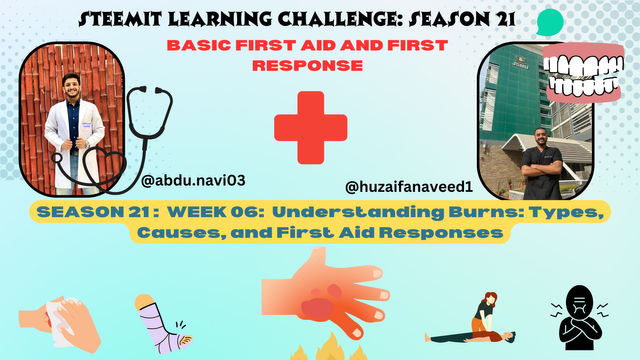
Burn or burn injury is actually the damage to the skin or deeper tissues due to contact with heat, chemicals, electricity, radiation, or by friction. Burn injuries can cause severe pain, redness of the skin, swelling, blistering and scarring. If the burn is severe it can lead to life-threatening complications like infections or shock.
Burn injuries can be categorized based on their causing reason.
1. Thermal Burns:
These are the most common burns, caused by direct contact with heat sources like flames, hot liquids, or hot objects.
For examples:
Flames (house fires, explosions), Scalds from hot liquids (boiling water, steam), Contact with hot objects (heated metal, stove tops)
2.Chemical Burns
These burns are caused by contact with corrosive substances like strong acids or bases, phenyls or detergents, hot oils spilled domestically.
- Examples:
Industrial chemicals (sulfuric acid, bleach), Cleaning agents (oven cleaners, pool chemicals)
3.Electrical Burns:
It is due to electrical current passing through the body and thus, damaging internal organs and causing burns at the points of contact.
• Examples:
High-voltage wires (power lines, electrical faults), Lightning strikes
4.Radiation Burns
These are caused by prolonged exposure to radiation, like ultraviolet (UV/sunburn) rays or rarely due to radiation from medical treatments like chemotherapy or radiotherapy.
5.Friction Burns
Occur when skin rubs against a hard surface like road, thus generating heat and causing abrasion or damage to the outer layer of the skin.
The severity of burn injury depends on many factors like the cause, intensity of the exposure, the duration of exposure, and the depth of tissue damage. The severity in a life-saving condition can be assessed by classifying burn into following bases:
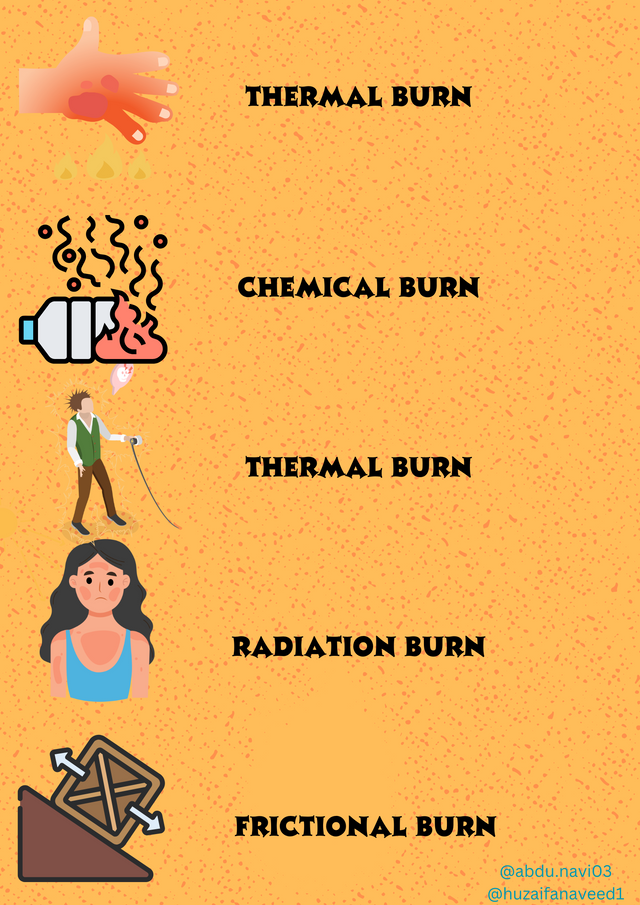
| Aspect | First-Degree Burns or Minor Burns | Second-Degree Burns or Moderate Burns | Third-Degree Burns or Major/Critical Burns |
|---|---|---|---|
| Layer Affected | Only epidermis (outermost layer of skin) is burnt. It’s the simplest/least severe type of burn. | Epidermis and part of the dermis are affected, leading to a deeper burn. | All skin layers, subcutaneous tissues, and even deeper structures are also affected in this degree of burn. |
| Appearance | Skin appears red and dry. | Skin appears red, blistered, and swollen. | Skin is white, charred, leathery, or waxy. |
| Location of Burn | Away from critical areas (face, hands, feet, genitals); usually on arms, forearms, thighs, and abdomen. | May involve critical areas or joints. | Involves critical areas like face, hands, feet, major joints, or genitals. |
| Pain | Pain is mild to moderate, bearable. | Severe and unbearable pain. | Often painless due to nerve damage. |
| Blisters Formation | No blister is formed. | Yes, a lot of blisters are present. | No, but severe damage to skin structure. |
| Surface Area Affected | <10% of total body surface area (TBSA) in adults is damaged. | 10–20% of TBSA in adults is damaged. | >20% of TBSA in adults or burns involving critical areas (face, hands, feet, genitals). |
| First Aid Requirement | Basic first aid (cooling, dressing). | Professional medical evaluation and dressing. | Immediate medical attention; may require surgery or ICU. |
| Healing Time | 3–7 days, if proper first-aid is provided on time. | 2–3 weeks (if superficial) and 6–7 weeks if deep. | These burns usually require medical intervention; healing may take months. |
| Examples | Sunburn, mild scalds. | Severe sunburn, hot liquid burns. | Electrical burns, fire burns, prolonged exposure to hot objects. |
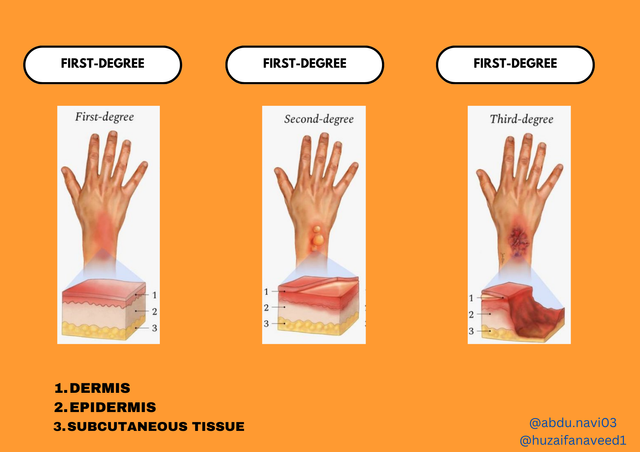
FIRST AID FOR BURNS: |
|---|
1. Scene Safety
Always ensure your and your scene’s safety, confirm that the area is safe for you and the victim. Avoid potential hazards like live wires, flames, or chemicals or better move the casualty away from the hazardous scene. Wear gloves/ wrapper around your hands or other protective equipment if available.
2. Stop the Burning Process
The very next step is to stop the burning process, for not to cause further damage to the body.
Thermal Burns: Avoid further thermal damage by removing the victim away from the source (extinguish flames or move away from a hot object).
Chemical Burns: Flush the affected area with running water for at least 20 minutes.
Electrical Burns: Turn off the electrical source before touching the victim.
3. SRABC Framework
Remember SRABC framework revising from our very first module till now? This framework ensures a systematic response to assess and manage the victim:
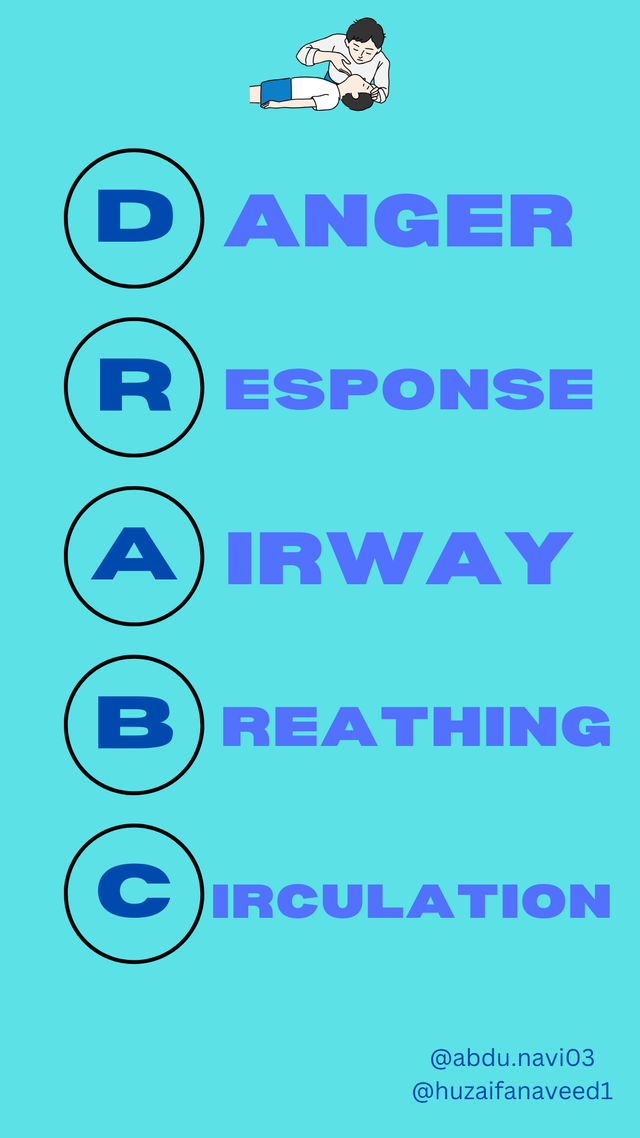
- S: Scene safety and Shout for Help
After assessing scene and your safety, Alert bystanders or call for help to assist in managing the situation, always remember 2 are better than 1 so ask for help as soon as possible. Activate emergency medical services (EMS) if needed, usually in mass burn cases.
- R: Response
Check if the victim is responsive, tap gently and ask, “Are you okay?” If unresponsive, proceed to assess airway, breathing, and circulation immediately.
- A: Airway
Ensure the airway is clearly open. Look for obstructions, especially if the burn is around the mouth or throat (inhalation injury). If unresponsive, open the airway using the head-tilt, chin-lift methods, taught in the first ever module.
- B: Breathing
Check for normal breathing for 10 seconds. If breathing is normal, proceed to burn management but if not breathing or breathing abnormally, begin CPR.
- C: Circulation
Check for a pulse and any signs of severe bleeding, if bleeding is present control that first. Monitor for signs of shock (pale skin, cold sweat, rapid breathing).
4. First Aid Management Based on Burn Severity
| Aspect | Minor Burns | Major Burns |
|---|---|---|
| Initial Step | Cool down the burn under running water for 10–20 minutes. | Stop the burning process (extinguish flames, avoid further exposure). |
| Cooling | Use cool (not cold) water or compresses. | Avoid immersion in water (it can lead to hypothermia or shock). |
| Cleaning | After 20 minutes, gently clean the area with mild soap and water. | Do not clean the area but cover it to prevent contamination. |
| Blisters | Do not pop any blister; leave intact to prevent infection. | Do not touch or disturb blisters. |
| Dressing | Apply sterile, non-stick dressing or gauze, as taught in the previous module. | Cover loosely with a clean, dry cloth or sterile dressing. |
| Pain Management | Over-the-counter pain relievers (e.g., ibuprofen). | Seek medical help; pain management will be handled by professionals. |
| Hydration | Encourage drinking water (especially if the burn is large). | Monitor for signs of dehydration and shock; provide fluids if conscious until medical professionals arrive. |
| Emergency Action | Not usually required, unless infection occurs. | Call emergency services immediately, even before moving towards the casualty. |
| Specific Cases | Avoid ointments, butter, or home remedies directly on the burn. | Remove any tight clothing or jewelry around the burn if safe. |
| Examples | Small scalds, sunburn. | Electrical burns, large flame burns, chemical burns. |
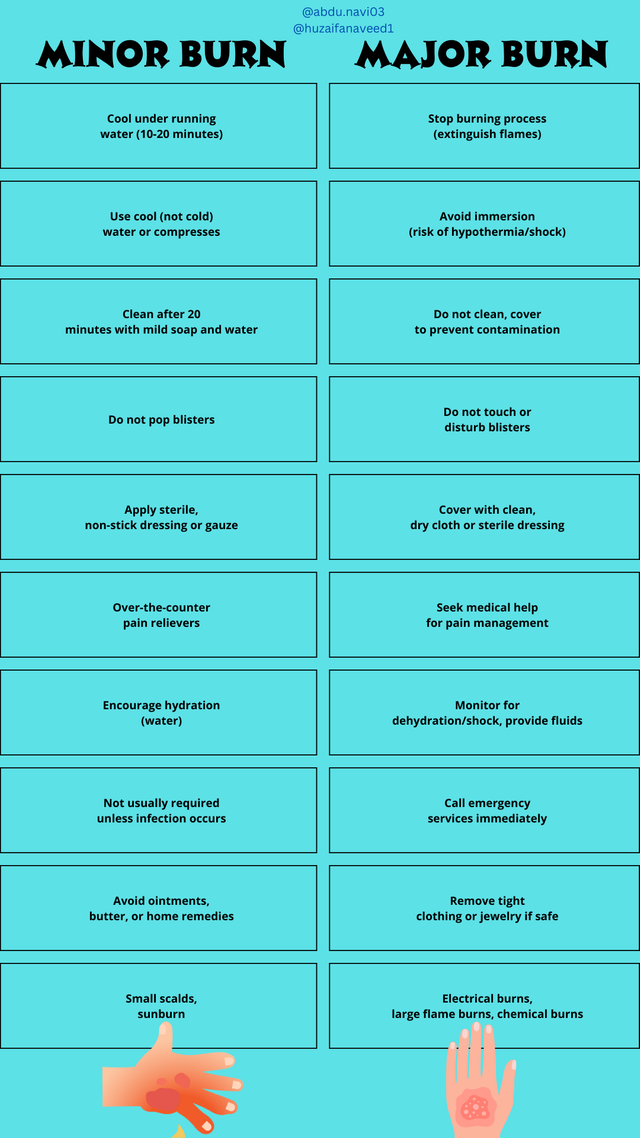
5. Special Considerations Based on Burn Type
- Chemical Burns:
Apart from normal first aid, the chemical burn injuries must be a slight change that is, continue flushing with water for a long period of time (at least 20 minutes). Remove contaminated clothing carefully.
- Electrical Burns:
Look for entry and exit wounds and other injuries caused by electrical shock (e.g., cardiac arrest). Perform CPR if needed.
- Radiation Burns:
Remember to treat minor burns, but consult a doctor if symptoms persist and if severe burn.
6. Monitor and Reassess
After providing basic first aid, keep checking the victim’s breathing, circulation, and level of consciousness until the professionals arrive. Be ready to perform CPR if they stop breathing.
Although first aid can provide a straight path to save one’s life but It’s crucial to avoid certain actions that can worsen the injury or delay proper healing. Here’s a list of what NOT to do when managing burns:
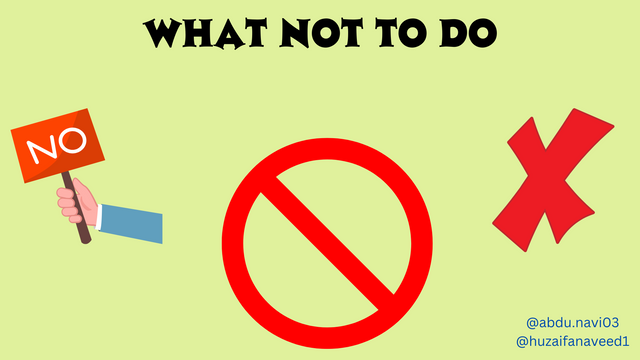
A. Do NOT move a burn victim unnecessarily:
Try not to move the casualty unnecessarily because, if they may have inhalation injuries, spinal injuries, or fractures, moving them can worsen their condition.
B. Do NOT use ice or ice-cold water:
As ice can cause frostbite and damage the burned tissue further, so avoid ice contact with the burn instead, use cool, running water. Lastly, do not delay the flushing of area with water, as immediate and prolonged rinsing is essential
C. Do NOT immerse large burns in water:
Immersing exposed tissue caused by burn, in water for a long period of time can lead to hypothermia, especially in children and elderly victims.
D. Do NOT pop blisters or peel off burned skin
Popping the blisters increases the risk of infection and scarring, as blisters protect the underlying skin from infection. Also, removing damaged skin can expose raw tissue and increase infection risks.
E. Do NOT apply direct pressure:
Burns are sensitive so direct pressure can aggravate the injury.
F. Do NOT apply butter, oil, or greasy substances:
These can trap heat, increase the risk of infection, and make cleaning the burn harder later.
G. Do NOT use ointments, creams, or lotions immediately:
These can trap heat, increase the risk of infection, and make cleaning the burn harder.
H. Do NOT use home remedies like toothpaste or egg whites:
These are not sterile and can lead to infection or allergic reactions. Moreover, these can trap heat, further increasing the risk of infection, and make cleaning the burn harder.
I. Do NOT use fluffy materials like cotton balls:
These fibers can stick to the burn and cause pain or infection during removal.
J. Do NOT wrap the burn tightly:
Tight bandages can restrict blood flow and worsen the injury.
K. Do NOT pull off clothing stuck to the burn:
Pulling the cloths as to remove them can cause further damage to the skin. Instead, cut around the clothing and leave stuck parts for medical professionals to handle.
L. Do NOT forget to remove tight jewelry or accessories:
Swelling can occur rapidly, making it difficult to remove these later, that’s why they should be removed as soon as possible.
M. Do NOT neutralize chemicals with other substances:
It’s a common mistake among common people like, they use vinegar to neutralize alkalis or baking soda for acids. These can cause a chemical reaction, worsening the injury. So, do not try this chemistry as a first aider!
N. Do NOT touch the victim without ensuring the electrical source is off:
You risk getting electrocuted yourself. Always disconnect the power or use non-conductive material to separate the victim from the source.
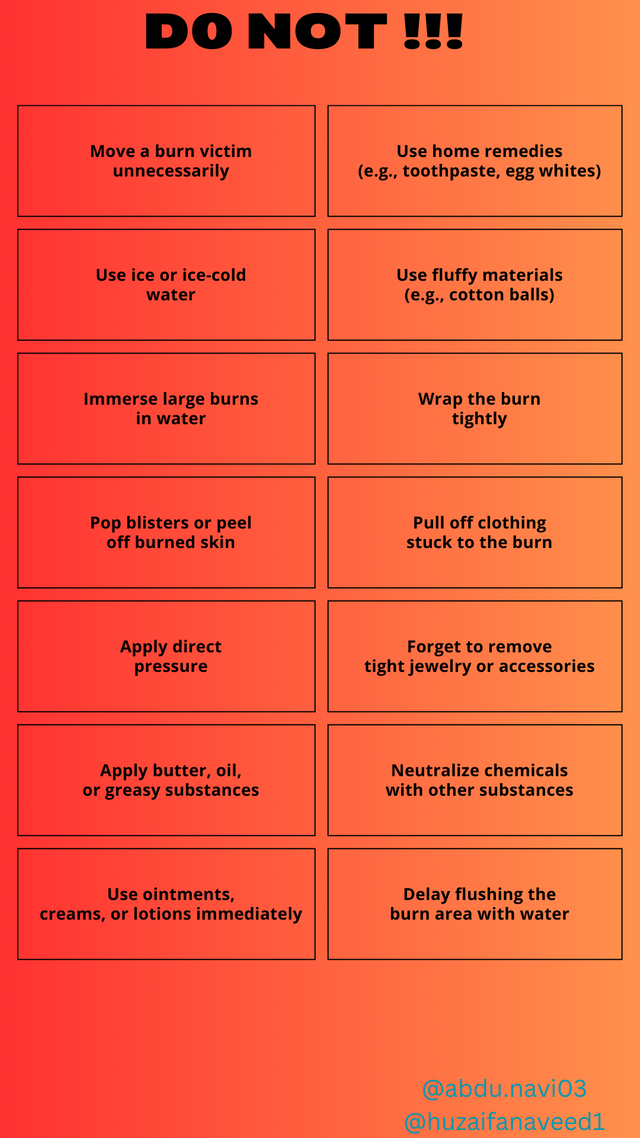
Burn victims can experience trauma and fear, so providing reassurance and emotional support is essential. Calm the victim, explain what you're doing, and encourage them to focus on their breathing to reduce panic.
Severe burns often require long-term care. Mention that burn victims might need:
Physical therapy to restore mobility and function, especially for burns near joints.
Psychological counseling to address trauma or body image concerns.
Wound care education for family members or caregivers.
HOMEWORK |
|---|
Q1:
Write a detailed first aid response for the following scenario:
" You witness a child accidentally spilling hot tea on their arm. What immediate steps will you take? What actions will you avoid?
Include considerations for burn severity and explain your reasoning. "
Q2:
"A worker in a warehouse suffers an electrical burn after touching exposed live wires. The burn site shows entrance and exit points, with damage to the skin and underlying tissues. What are the immediate first aid actions you should take, and what critical steps should you avoid? How does this differ from treating thermal burns?"
Q3:
"A worker in a factory accidentally spills a strong acid on their arm, causing immediate pain, redness, and blistering. A colleague tries to wash it off with water but notices the burn spreading."
a. Identify the type of burn.
b. What went wrong during the initial first aid?
c. Propose the correct first aid steps and explain why each step is important..
Q4:
You are a first responder in a rural area. Two people are injured in a house fire:
Person A has a large area of third-degree burns but is conscious and calm.
Person B has second-degree burns on both legs and is in severe pain.
You can only help one person immediately due to resource constraints.
Whom do you prioritize, and why? Support your decision with medical and ethical reasoning.
Q5:
Create an infographic on burn management. Include the following:
a. Types of Burns and Their Causes (Electrical, Thermal, etc)
b. Different types of burns (1st, 2nd, and 3rd degree)
c. First aid steps for minor and major burns
d. What NOT to Do During Burn First Aid." Use visuals and short explanations for each point.
RULES |
|---|
Your title should be "SLC21/WK6: Understanding Burns: Types, Causes, and First Aid Responses "
Make sure to use the #firstaid-s21w6 , #steemexclusive, #teachingteam , #learnwithsteem tags, and your country's tag (e.g., #pakistan)
Plagiarism or the use of artificial intelligence of any kind will not be tolerated.
Only your own images will be accepted (Try to create it on various softwares like Canva, etc) Images for free use will not be allowed.
Write a minimum of 800 words
The link of your task must be added in the comments of this publication.
Use the #burnsteem25 tag only if you have set the 25% payout to @null.
You can publish homework in any community and in any language. But don't forget to use the original tag.
Invite three of your active Steemian friends.
The participation schedule is between Monday, December 1st, 2024, at 00:00 UTC to Sunday, - December 8th, 2024, at 23:59 UTC.
REWARDS |
|---|
SC01/SC02 would be checking on the entire 17 participating Teaching Teams and Challengers and upvoting outstanding content. Upvote is not guaranteed for all articles. Kindly take note.
At the end of the contest, I will be nominating four (04) users who have had a great performance in the contest and have complied with the previously established, and therefore, are eligible to receive SC01/SC02 votes.
Contact Information (Discord)
@abdu.navi03 (abdu.navi03)
@huzaifanaveed1 (huzaifa_1114)
Best regards,
Dr @abdu.navi03
Dr @huzaifanaveed1
Hello @abdu.navi03 thank you for this teaching.
Here is my entry
https://steemit.com/hive-147599/@beewrites/slc21-wk6-understanding-burns-types-causes-and-first-aid-responses
Best regards, here is my participation post :
https://steemit.com/hive-111300/@fantvwiki/slc21-wk6-understanding-burns-types-causes-and-first-aid-responses
greetings to the respected doctor for this post.
https://steemit.com/firstaid-s21w6/@steem-wariors/slc21-wk6-understanding-burns-types-causes-and-first-aid-responses
My entry https://steemit.com/hive-168205/@alysaa/slc21-wk6-understanding-burns-types-causes-and-first-aid-responses
https://steemit.com/firstaid-s21w6/@aril.hatake/slc21-wk6-understanding-burns-types-causes-and-first-aid-responses
Here is my entry
https://steemit.com/hive-183369/@memamun/slc21-wk6-understanding-burns-types-causes-and-first-aid-responses
https://steemit.com/hive-118902/@xkool24/slc21-wk6-understanding-burns-types-causes-and-first-aid-responses
My entry:
https://steemit.com/firstaid-s21w6/@kouba01/slc21-wk6-understanding-burns-types-causes-and-first-aid-responses
https://steemit.com/burnsteem25/@yenny47/slc21-wk6-comprension-de-las-quemaduras-tipos-causas-y-respuestas-de-primeros-auxilios
https://steemit.com/hive-118902/@ninapenda/slc21-wk6-understanding-burns-types-causes-and-first-aid-responses